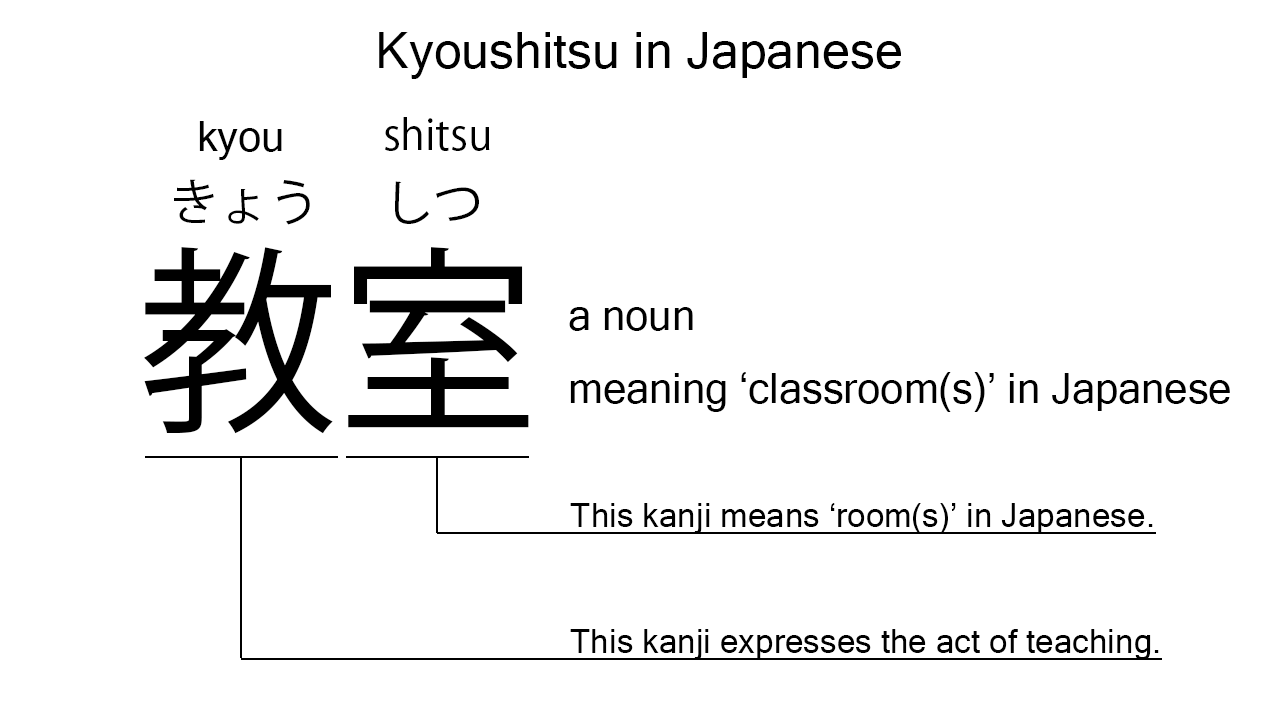What does “kyoushitsu” mean in Japanese?
Native speakers say “kyoushitsu” to mean ‘classroom’ in Japanese. Perhaps, some Japanese learners know this word as it is sometimes used in Japanese movies, songs, novels, manga, anime, and the like. In this blog post, however, I will explain it in detail based on its kanji expression. And also, I will explain how to use it through example sentences. My explanations would help Japanese learners to understand “kyoushitsu” more clearly. Then, let’s get started!
Contents
Definition and meaning of “kyoushitsu”
Let me start with the definition and meaning of “kyoushitsu”.
- kyoushitsu – 教室 (きょうしつ) : a noun meaning ‘classroom’ in Japanese. This can also work as plural. Learn more about Japanese plural.
The definition and meaning are very simple and clear, I think. To understand this noun more clearly, however, let me explain its kanji characters in detail, one by one.
Kyoushitsu in kanji
The kanji expression of “kyoushitsu” consists of the following two kanji characters:
- 教 : a kanji character used to express the act of teaching. This can also be found in other words like “oshieru“.
- 室 : a kanji character often used as a suffix to add the meaning of ‘room’.
These two kanji characters tell us that “kyoushitsu” literally means ‘teaching room’ in Japanese. This literal interpretation is not completely in line with the meaning, but still very close, I think. Classrooms are, anyway, rooms where someone teaches something to someone else.

When we meet new kanji expressions, we should check their kanji characters in detail to understand their meanings clearly and deeply. In many cases, kanji characters tell us a lot about the meanings of the expressions they form. Actually, here, we could get the better understanding of “kyoushitsu” through the detailed kanji check above.
So far, I’ve explained the definition and meaning of “kyoushitsu” together with its kanji characters. Then, let me explain how to use it through the example sentences below.
Example #1: how to say “classroom” in Japanese
kanojo wa mada kyoushitsu ni iru – 彼女はまだ教室に居る (かのじょはまだきょうしつにいる)
She is still in a classroom.
Below are the new words used in the example sentence.
- kanojo – 彼女 (かのじょ) : a pronoun meaning ‘she’ in Japanese.
- wa – は : a binding particle working as a case marker or topic marker. In the example, this works after “kanojo” to make the subject in the sentence.
- mada – まだ : an adverb meaning ‘still’ or such in Japanese. This can work almost anywhere in a sentence.
- ni – に : a case particle used to say where someone or something is. In the example, this is used after “kyoushitsu” to say where “kanojo” is.
- iru – 居る (いる) : a verb meaning ‘to be’, ‘to present’, or such in Japanese.
This is a typical usage of “kyoushitsu”. In the example, it works as a part of the phrase, “kyoushitsu ni iru”, which literally means ‘to be in a classroom’ in Japanese.
Example #2: another usage of “kyoushitsu”
watashi tachi no kyoushitsu wa kitanakat ta – 私達の教室は汚かった (わたしたちのきょうしつはきたなかった)
Our classroom was messy.
Below are the new words used in the example sentence.
- watashi – 私 (わたし) : a pronoun meaning ‘I’ in Japanese.
- tachi – 達 (たち) : a suffix used after a noun or pronoun to make its plural form. In the example, this is used after “watashi” to make its plural form, “watashi tachi”, which means ‘we’ in Japanese.
- no – の : a case particle used after a noun or pronoun to make its possessive case. In the example, this is used after “watashi tachi” to make its possessive case, “watashi tachi no”, which means ‘our’ in Japanese.
- kitanakat – 汚かっ (きたなかっ) : one conjugation of the i-adjective, “kitanai“, which means ‘messy’ or such in Japanese. In the example, it has been conjugated for the better connection with its following word.
- ta – た : an auxiliary verb used after a verb, adjective, or auxiliary verb to make its past tense form. Probably, this is well known as a part of Japanese ta form. In the example, this is used after “kitanakat” to make its past tense form, “kitanakat ta”.
This is another typical usage of “kyoushitsu”. In this example, it works as a part of the noun phrase, “watashi tachi no kyoushitsu”, which means ‘our classroom’ in Japanese. When we want to say “classroom” in Japanese, anyway, this noun is always a very good option.
Summary
In this blog post, I’ve explained the definition and meaning of “kyoushitsu” in detail based on its kanji expression. And also, I’ve explained how to use it through the example sentences. Let me summarize them as follows.
- kyoushitsu – 教室 (きょうしつ) : a noun meaning ‘classroom’ in Japanese. This can also work as plural. These two kanji characters literally mean ‘teaching room’ in Japanese. This literal interpretation is not completely in line with the meaning, but still very close, I think. Classrooms are, anyway, rooms where someone teaches something to someone else.
Hope my explanations are understandable and helpful for Japanese learners.